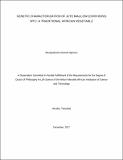Genetic characterization of jute mallow (corchorus spp.): a traditional African vegetable
Abstract
Jute mallow (Corchorus spp.) is a very nutritious traditional leafy vegetable. Its leaves contain an average of 15% dry matter,4.8 g of protein, 259 mg of calcium, 4.5 mg of iron, 4.7 mg of vitamin A, 92 μg of folate, 1.5 mg of nicotinamide and 105 mg of ascorbic acid per 100g of leaves. In spite of its nutritional importance, cultivation of Jute mallow is limited due to lack of scientific information with regard to available cultivars and their adaptation to specific environments. The aim of this study was to analyze the genetic diversity and evaluate the accessions which are well adapted to specific environment for leaf and seeds production. Ninety accessions were evaluated in the field trial experiments for two growing seasons. ISSR and SSR markers were employed for molecular characterization as well as leaf and seed yield evaluation. The results showed significant (p<0.01) variability in accessions in all morphological traits. Traits such as plant height (r=0.448), petiole length (r=0.237), primary branches (r=0.319) and number of leaves per plant (r=0.333) were significantly (p<0.01) correlated with biomass yield. First five Principal components (PCs) with Eigen values ≥1 explained 72.9% of the total variability in the accessions. Cluster analysis grouped the accessions into five major clusters mainly based on their origin. Number of alleles per locus ranged from 2-4 with an average of 2.63 alleles per locus. Polymorphic information content (PIC) ranged from 0.278 in primer SSR17 to 0.78 in primer SSR24. Average Nei‘s gene diversity (h) and Shannon‘s information index (I) were 0.348 and 0.557, respectively. In ISSR markers a total of 85 bands were amplified and average polymorphic bands per primer was 2.75. PIC values ranged from 0.39 to 0.76 with average of 0.53. The highest Nei‘s pair wise genetic distance (0.431) was observed in East African accessions. UPGMA cluster analysis grouped the accessions into five main clusters at genetic similarity coefficient of 0.53. In terms of leaf and seed yield, significant (p<0.01) differences among the accessions in all traits was observed. Leaf fresh weight ranged from 18.3g/plant to 121.3g/plant in accessions TOT 6747 and TOT 8532, respectively. Seed yield ranged from 1.0g/plant to 35.5g/plant in accessions TOT 7980 including eight others and TOT 7866, respectively. Evaluation of genetic diversity and the agronomic traits for leaf and seed yield in this germplasm has revealed useful information for breeders in their efforts to improve the yield as well as selection of accessions with good agronomic traits. It is recommended that detailed study to document ethnomenclacture, ethnobotanical uses, progress towards domestication and challenges faced by farmers be conducted.

